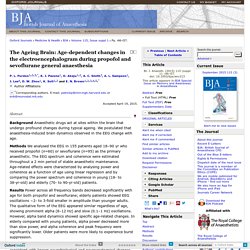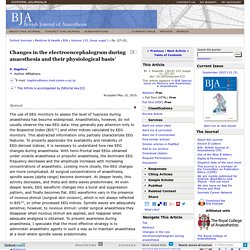

Clinical Education – Patrick Purdon Laboratory. Nihms709731. Module 1: Intro to Waveforms and Spectrogram by DREAMER Education Team on Prezi. Marchant ClinEEGNeurosci2014. Clinical Electroencephalography for Anesthesiologists Part I: Background and Basic Signatures. Neural correlates of consciousness - ScienceDirect Topics. It is often assumed in the debate concerning the nature of consciousness that there are few relevant facts and therefore everybody is entitled to their own theory of consciousness.

Nothing could be further from the truth. There is an immense amount of psychological, clinical, and neuroscientific data and observations that need to be accounted for. In particular, the contemporary focus on the neuronal basis of consciousness in the brain – rather than on eristic philosophical debates concerning exact definitions, whether true zombies can exist, or whether or not the Hard Problem can or cannot be solved – has given neuroscientists the tools to effectively attack this problem. As defined by FC Crick and C Koch, the neuronal correlates of consciousness (NCC) are the minimal neuronal mechanisms jointly sufficient for any one specific conscious percept (minimal, as the entire brain is sufficient to give rise to consciousness).
What characterizes the NCC? 2727. The Ageing Brain: Age-dependent changes in the electroencephalogram during propofol and sevoflurane general anaesthesia. + Author Affiliations ↵*Corresponding authors.

E-mail: patrickp@nmr.mgh.harvard.edu or enb@neurostat.mit.edu Accepted April 19, 2015. Abstract Background Anaesthetic drugs act at sites within the brain that undergo profound changes during typical ageing. Changes in the electroencephalogram during anaesthesia and their physiological basis. Abstract The use of EEG monitors to assess the level of hypnosis during anaesthesia has become widespread.

Anaesthetists, however, do not usually observe the raw EEG data: they generally pay attention only to the Bispectral Index (BIS™) and other indices calculated by EEG monitors. This abstracted information only partially characterizes EEG features. To properly appreciate the availability and reliability of EEG-derived indices, it is necessary to understand how raw EEG changes during anaesthesia. With hemi-frontal lead EEGs obtained under volatile anaesthesia or propofol anaesthesia, the dominant EEG frequency decreases and the amplitude increases with increasing concentrations of anaesthetic. Editor's key points Anaesthetists commonly use processed electroencephalographic data to guide anaesthesia, but the raw EEG can be more informative. During the past few decades, EEG monitors, such as the BIS™ monitor (Covidien, Boulder, CO USA), have become widely used. Memory formation during anaesthesia: plausibility of a neurophysiological basis.
Abstract As opposed to conscious, personally relevant (explicit) memories that we can recall at will, implicit (unconscious) memories are prototypical of ‘hidden’ memory; memories that exist, but that we do not know we possess.

Nevertheless, our behaviour can be affected by these memories; in fact, these memories allow us to function in an ever-changing world. It is still unclear from behavioural studies whether similar memories can be formed during anaesthesia. Thus, a relevant question is whether implicit memory formation is a realistic possibility during anaesthesia, considering the underlying neurophysiology. A different conceptualization of memory taxonomy is presented, the serial parallel independent model of Tulving, which focuses on dynamic information processing with interactions among different memory systems rather than static classification of different types of memories. Ep-manual. PNAS-2013-Purdon-1221180110.
Electroencephalographic Mapping During Routine.25. American Clinical Neurophysiology Society. Simultaneous Electroencephalographic and.14. Br Med Bull-2013-Vacas-161-78. Sleep and Anesthesia Interactions: A Pharmacological Appraisal. Introduction The anesthetic state is characterized by alteration in level of consciousness, decreased responsiveness to external stimuli, amnesia, decreased muscle tone, and altered autonomic responsiveness.

The degree to which each of these effects is achieved depends both on the anesthetic agent and its dose. Individual anesthetics have variable efficacy in eliciting each of the components of the anesthetic state suggesting that subtle, yet important differences exist in their molecular mechanisms of action. The precise way anesthetics work remains mysterious. In this review, we focus upon anesthetic actions in the neuronal systems known to modulate sleep and arousal. Neuroimaging studies have proven to be a powerful tool in studying the minimal neuronal substrates required for conscious perception and the effects of anesthetic agents in disrupting consciousness [3, 4•, 5]. Brainstem During REM sleep, GABA levels in the PRF decreased and acetylcholine levels increased [28]. Association between the Apolipoprotein E4 and.19. Internet Scientific Publications.
How-deep-is-deep-enough-2155-6148.1000e115. General anesthesia, sleep and coma. Nihms315743. Methylphenidate Actively Induces Emergence from General Anesthesia. General Anesthesia: Activating a Sleep Switch?: Current Biology. MIT : Brain and Cognitive Sciences. BMJ Open 2014 Avidan. Does Intraoperative Ketamine Attenuate 32[1] El Dr. Emery N Brown en Madrid. El Dr.

Emery Brown estuvo en Madrid y Barcelona (España) y todos los que pudimos asistir a su conferencia pudimos constatar el tremendo campo de investigación que queda por recorrer en el terreno de la anestesiología. ¿Qué pasa con nuestros pacientes cuando les administramos fármacos que inciden en el estado de consciencia? Por no decir ¿Qué les pasa cuando los sometemos a una anestesia general?. Son unas preguntas con muy pocas respuestas y muchas más incognitas de lo que suponemos. El Dr. Emery Brown es profesor en Harvard, dirige un departamento en el MIT y es anestesiólogo en el Hospital General de Massachusetts. A Look at the Unconscious Brain Under General Anesthesia. Revealing the Brain through States of Unconsciousness:
SASM_13AM_Solt_Handout.